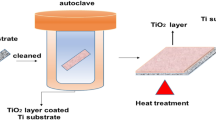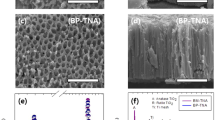Abstract
Owing to its low cost and plentiful different semiconductor configurations resources, photoelectrocatalysis (PEC) has come into the spotlight in large-scale water purification systems. However, the insufficiency of photoelectrocatalytic performance and the issues of long-term durability of current electrode materials are the main bottlenecks for future latent applications. Here, we reported that the multidimensional Ti/SnO2-Sb/PbO2/ZnO nanoarchitecture (PbO2 nanotrees grown on Sb-doped SnO2 nanowires, then ZnO nanowall embedded into PbO2 nanotrees’ skeleton) significantly boosts the PEC properties in terms of the organic contaminated water treatment (i.e., reactive brilliant blue KN-R). Benefiting from the synergistic effects of ZnO and PbO2 (the ZnO can be used as the supply station of water, promptly transferring water molecules to adjacent PbO2 to yield hydroxyl radicals), Ti/SnO2-Sb/PbO2/ZnO electrode manifests an unprecedented removal rate of dye, large electroactive areas, noticeable wettability, and high separation efficiency of induced carriers, better stability, which represents a type of promising material in the applications of water purification.







Similar content being viewed by others
References
Martínez-Huitle CA, Brillas E (2009) Decontamination of wastewaters containing synthetic organic dyes by electrochemical methods: a general review. Appl Catal B Environ 87(3-4):105–145
Wang H, Liang YH, Liu L, Hu JS, Wu P, Cui WQ (2017) Enriched photoelectrocatalytic degradation and photoelectric performance of BiOI photoelectrode by coupling r-GO. Appl Catal B Environ 208:22–34
Lyu JH, Sun GJ, Zhu LY, Ma HC, Ma C, Dong XL, Fu YH (2020) Fabrication of Ti/black TiO2-PbO2 micro/nanostructures with tunable hydrophobic/hydrophilic characteristics and their photoelectrocatalytic performance. J Solid State Electrochem 24(2):375–387
Wang Z, Yang CY, Lin TQ, Yin H, Chen P, Wan DY, Xu FF (2013) Visible-light photocatalytic, solar thermal and photoelectrochemical properties of aluminium-reduced black titania. Energy Environ Sci 6(10):3007–3014
Ma DT, Li YL, Mi HW, Luo S, Zhang PX, Lin ZQ, Li JQ, Zhang H (2018) Robust SnO2-x nanoparticle-impregnated carbon nanofibers with outstanding electrochemical performance for advanced sodium-ion batteries. Angew Chem Int Ed 57(29):8901–8905
Yu XT, Wang MY, Gong XZ, Guo ZC, Wang Z, Jiao SQ (2018) Self-supporting porous CoP-based films with phase-separation structure for ultrastable overall water electrolysis at large current density. Adv Energy Mater 8(34):1802445
Li XH, Pletcher D, Walsh FC (2011) Electrodeposited lead dioxide coatings. Chem Soc Rev 40(7):3879–3894
Martinez-Huitle CA, Ferro S (2006) Electrochemical oxidation of organic pollutants for the wastewater treatment: direct and indirect processes. Chem Soc Rev 35(12):1324–1340
Wang YG, Song YF, Xia YY (2016) Electrochemical capacitors: mechanism, materials, systems, characterization and applications. Chem Soc Rev 45(21):5925–5950
Cotillas S, Llanos J, Canizares P (2018) Removal of Procion Red MX-5B dye from wastewater by conductive-diamond electrochemical oxidation. Electrochim Acta 263:1–7
He HX, Li WB, Deng HY, Ren LP, Zhang YF, Zhu L, Xie J, Li T (2019) Surface characteristics of a recyclable and efficient adsorption material. Mater Lett 256:126658
Sheng X, Liu Z, Zeng RS, Chen LP, Fen XJ, Jiang L (2017) Enhanced photocatalytic reaction at air-liquid-solid joint interfaces. J Am Chem Soc 139(36):12402–12405
Liu HJ, Meng CW, Zhang SS (2018) One-pot hydrothermal synthesis of SnO2/BiOBr heterojunction photocatalysts for the efficient degradation of organic pollutants under visible light. ACS Appl Mater Interfaces 10(34):28686–28694
Liu Y, Jiao Y, Zhang ZL, Qu FY (2014) Hierarchical SnO2 nanostructures made of intermingled ultrathin nanosheets for environmental remediation, smart gas sensor, and supercapacitor applications. ACS Appl Mater Interfaces 6(3):2174–2184
Ju S, Jun J, Huh D (2019) Simultaneous improvement of absorption and separation efficiencies of Mo:BiVO4 photoanodes via nanopatterned SnO2/Au hybrid layers. ACS Sustain Chem Eng 7(20):17000–17007
Bi Q, Guan WZ, Gao Y, Cui YR, Ma SW, Xue JQ (2019) Study of the mechanisms underlying the effects of composite intermediate layers on the performance of Ti/SnO2-Sb-La electrodes. Electrochim Acta 306:667–679
Böhm D, Beetz M, Schuster M (2019) Efficient OER catalyst with low Ir volume density obtained by homogeneous deposition of iridium oxide nanoparticles on macroporous antimony-doped tin oxide support. Adv Funct Mater 30(1):1906670
Zhang Y, He P, Jia LP, Zhang TH, Liu HH, Wang S (2019) Dimensionally stable Ti/SnO2-RuO2 composite electrode based highly efficient electrocatalytic degradation of industrial gallic acid effluent. Chemosphere 224:707–715
Ansari A, Nematollahi D (2020) Convergent paired electrocatalytic degradation of p-dinitrobenzene by Ti/SnO2-Sb/β-PbO2 anode. A new insight into the electrochemical degradation mechanism. Appl Catal B Environ 261:118226
Kresse G, Furthmüller J (1996) Efficiency of ab-initio total energy calculations for metals and semiconductors using a plane-wave basis set. Comput Mater Sci 6(1):15–50
Kresse G, Furthmüller J (1996) Efficient iterative schemes for ab initio total-energy calculations using a plane-wave basis set. Phys Rev B 54(16):11169–11186
Perdew JP, Burke K, Ernzerhof M (1996) Generalized gradient approximation made simple. Phys Rev Lett 77(18):3865–3868
Yang C, Wang YM, Hu B, Zhang H, Lv YQ, Zhou XF (2018) Optimized fabricationof TiO2 nanotubes array/SnO2-Sb/Fe-doped PbO2 electrode and application in electrochemical treatment of dye wastewater. J Electron Mater 47(10):5965–5972
Lyu JH, Han HB, Wu Q, Ma HC, Ma C, Dong XL, Fu YH (2019) Enhancement of the electrocatalytic oxidation of dyeing wastewater (reactive brilliant blue KN-R) over the Ce-modified Ti-PbO2 electrode with surface hydrophobicity. J Solid State Electrochem 23(3):847–859
Qiu JH, Guo M, Wang XD (2011) Electrodeposition of hierarchical ZnO nanorod-nanosheet structures and their applications in dye-sensitized solar cells. ACS Appl Mater Interfaces 3(7):2358–2367
Wang XQ, Wu Q, Ma HC, Ma C, Yu ZH, Fu YH, Dong XL (2019) Fabrication of PbO2 tipped Co3O4 nanowires for efficient photoelectrochemical decolorization of dye (reactivebrilliant blue KN-R) wastewater. Sol Energy Mater Sol Cells 191:381–388
Costa IM, Colmenares YN, Pizani PS (2018) Sb doping of VLS synthesized SnO2 nanowires probed by Raman and XPS spectroscopy. Chem Phys Lett 695:125–130
Adams B, Tian M, Chen A (2009) Design and electrochemical study of SnO2-based mixed oxide electrodes. Electrochim Acta 54(5):1491–1498
Nguyen CPT, Raja J, Kim S, Jang K (2017) Enhanced electrical properties of oxide semiconductor thin-film transistors with high conductivity thin layer insertion for the channel region. Appl Surf Sci 396:1472–1477
Zhao GH, Zhang YG, Lei YZ, Lv BY, Gao JX, Zhang YN, Li DM (2010) Fabrication and electrochemical treatment application of a novel lead dioxide anode with superhydrophobic surfaces, high oxygen evolution potential, and oxidation capability. Environ Sci Technol 44(5):1754–1759
Wooh S, Encinas N, Vollmer D, Butt HJ (2017) Stable hydrophobic metal-oxide photocatalysts via grafting polydimethylsiloxane brush. Adv Mater 29(16):1604637
Du HB, Duan GY, Wang N, Liu J, Tang Y, Ran P, Chen YM, Wan PY (2018) Fabrication of Ga2O3-PbO2 electrode and its performance in electrochemical advanced oxidation processes. J Solid State Electrochem 22(12):3799–3806
Qian S, Liu S, Jiang ZY, Deng DL, Zhang JZ (2019) Electrochemical degradation of tetracycline antibiotics using a Ti/SnO2-Sb2O3/PbO2 anode: kinetics, pathways, and biotoxicity change. J Electrochem Soc 166(6):192–199
Lyu JH, Liu XH, Chen Y, Li HJ, Li RC (2020) Highly enhanced photoelectrocatalytic oxidation via cooperative effect of neighboring two different metal oxides for waterpurification. J Phys Chem C 124(21):11525–11535
Kong DZ, Luo JS, Wang YL (2014) Three-dimensional Co3O4@MnO2 hierarchical nanoneedle arrays: morphology control and electrochemical energy storage. Adv Funct Mater 24(24):3815–3826
Ma HC, Cheng XH, Ma C, Dong XL, Zhang XF, Xue M (2013) Synthesis, characterization, and photocatalytic activity of n-doped ZnO/ZnS composites. Int J Photoenergy 2013:749–756
Funding
This work was supported by the National Natural Science Foundation of China (21875026, 21878031); the project is also sponsored by Liaoning BaiQianWan Talents Program, the scientific research fund of the educational department of Liaoning province (J2019013). This work was also supported by the Joint Research Fund Liaoning-Shenyang National Laboratory for Materials Science (Project number: 2019JH3/30100034; Contract number: 2019010278-JH3/301).
Author information
Authors and Affiliations
Corresponding authors
Ethics declarations
Conflict of interest
The authors declare that they have no conflicts of interest.
Additional information
Publisher’s note
Springer Nature remains neutral with regard to jurisdictional claims in published maps and institutional affiliations.
Supplementary Information
ESM 1
(DOCX 13219 kb).
Rights and permissions
About this article
Cite this article
Li, H., Lyu, J., Chen, Y. et al. Consecutive metal oxides with self-supported nanoarchitecture achieves highly stable and enhanced photoelectrocatalytic oxidation for water purification. J Solid State Electrochem 25, 1083–1092 (2021). https://doi.org/10.1007/s10008-020-04886-7
Received:
Revised:
Accepted:
Published:
Issue Date:
DOI: https://doi.org/10.1007/s10008-020-04886-7




